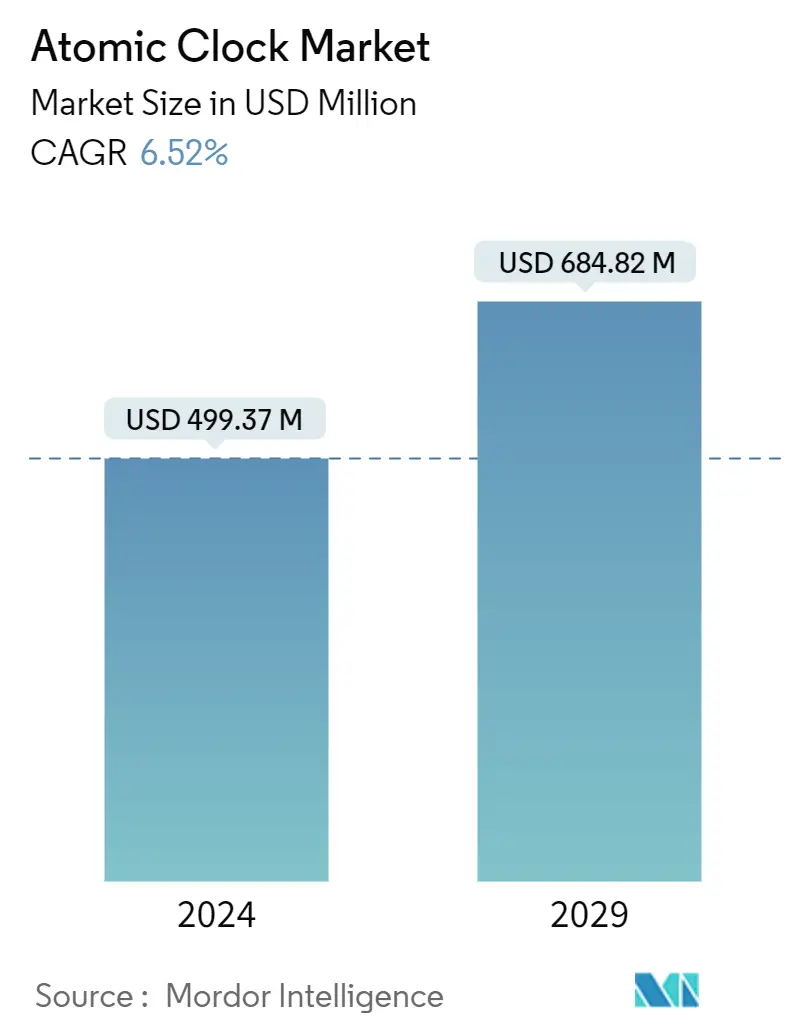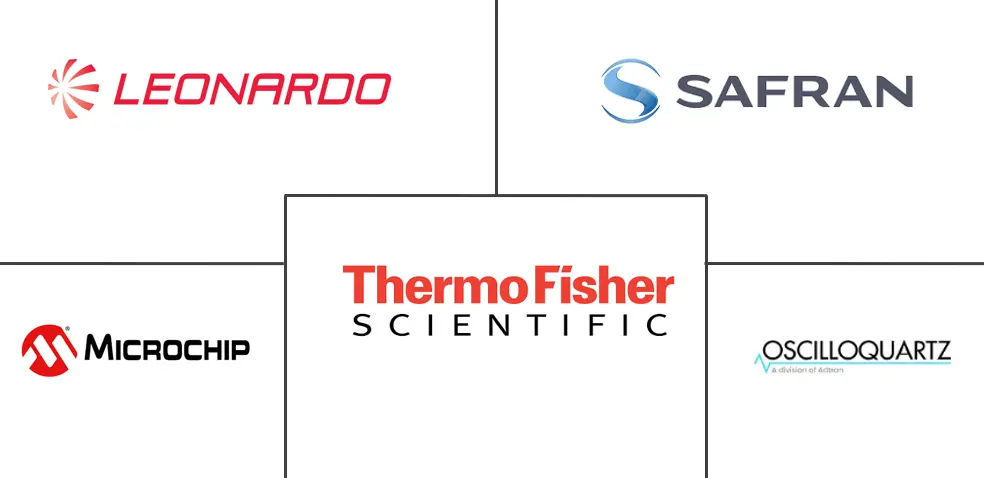Market Size of Atomic Clock Industry

| Study Period | 2019 - 2029 |
| Market Size (2024) | USD 499.37 Million |
| Market Size (2029) | USD 684.82 Million |
| CAGR (2024 - 2029) | 6.52 % |
| Fastest Growing Market | Asia Pacific |
| Largest Market | North America |
| Market Concentration | Medium |
Major Players
*Disclaimer: Major Players sorted in no particular order |
Atomic Clock Market Analysis
The Atomic Clock Market size is estimated at USD 499.37 million in 2024, and is expected to reach USD 684.82 million by 2029, growing at a CAGR of 6.52% during the forecast period (2024-2029).
The atomic clock market's growth is attributed to the increasing need for high-precision atomic clocks in the aerospace and military sectors. Atomic clocks guarantee accurate one-way range measurements, ensuring the user maintains the transmitted GPS signal's phase precision. Developments in quantum computing and quantum communication are expected to create better opportunities for the market.
The expansion of global navigation and positioning systems and the rise of atomic clock applications in GPS and GNSS systems are also fueling the growth of the atomic clock market. However, the high cost of deployment and maintenance may hinder the market's growth during the forecast period.
Atomic Clock Industry Segmentation
An atomic clock uses a resonator with resonance frequencies of atoms. A resonator is regulated by the frequency of microwave electromagnetic radiation emitted by the quantum transition of an atom. Resonation at extremely consistent frequencies is possible, an added advantage to this approach. In terms of accuracy and precision, atomic clocks are the most accurate.
The market is segmented by application, type, end user, and geography. According to type, the market is divided into cesium (Cs) atomic clock, rubidium (Rb) atomic clock, and hydrogen (H) maser atomic clock. The market is segmented into surveillance, navigation, electronic warfare, telemetry, and communication-based on application. By end user, the market is segmented into defense and space. The report includes the market size and forecasts in significant countries across different regions. The forecasts and market sizes have been provided in value (USD).
| Type | |
| Rubidium (Rb) Atomic Clock | |
| Cesium (Cs) Atomic Clock | |
| Hydrogen (H) Maser Atomic Clock |
| End User | |||||||||
| |||||||||
| Space |
| Application | |
| Surveillance | |
| Navigation | |
| Electronic Warfare? | |
| Telemetry | |
| Communication |
| By Geography | ||||||||||
| ||||||||||
| ||||||||||
| ||||||||||
| ||||||||||
|
Atomic Clock Market Size Summary
The atomic clock market is poised for significant growth, driven by the increasing demand for high-precision timekeeping in aerospace and military applications. This demand is largely fueled by the need for accurate navigation and positioning systems, such as GPS and GNSS, which are critical for modern defense and aerospace operations. The market is also benefiting from advancements in quantum computing and communication, which are expected to open new avenues for growth. However, the high costs associated with the deployment and maintenance of atomic clocks may pose challenges to market expansion. The defense sector, in particular, is a major contributor to market growth, as countries invest in modernizing their military fleets with advanced navigation systems. Initiatives like the US Air Force's integration of next-generation GPS receivers highlight the ongoing efforts to enhance military capabilities, which in turn drive demand for atomic clocks.
The competitive landscape of the atomic clock market is characterized by a semi-consolidated structure, with key players such as Thermo Fisher Scientific Inc., Oscilloquartz, Microchip Technology Inc., Leonardo SpA, and Safran vying for market share. These companies leverage their manufacturing capabilities, global presence, and investment in research and development to maintain a competitive edge. The market is expected to see intensified competition due to technological innovations and the expansion of product offerings. Recent developments, such as Microchip Technology Inc.'s launch of the 5071B cesium atomic clock and Orolia SA's upgraded miniaturized rubidium oscillator, underscore the industry's focus on meeting the evolving demands of military and aerospace sectors. As the market continues to grow, the interplay of technological advancements and strategic investments will be crucial in shaping its future trajectory.
Atomic Clock Market Size - Table of Contents
-
1. MARKET DYNAMICS
-
1.1 Market Overview
-
1.2 Market Drivers
-
1.3 Market Restraints
-
1.4 Porter's Five Forces Analysis
-
1.4.1 Bargaining Power of Buyers/Consumers
-
1.4.2 Bargaining Power of Suppliers
-
1.4.3 Threat of New Entrants
-
1.4.4 Threat of Substitute Products
-
1.4.5 Intensity of Competitive Rivalry
-
-
-
2. MARKET SEGMENTATION
-
2.1 Type
-
2.1.1 Rubidium (Rb) Atomic Clock
-
2.1.2 Cesium (Cs) Atomic Clock
-
2.1.3 Hydrogen (H) Maser Atomic Clock
-
-
2.2 End User
-
2.2.1 Defense
-
2.2.1.1 Combat Aircraft and Helicopters?
-
2.2.1.2 Unmanned Vehicles?
-
2.2.1.3 Armoured Vehicles
-
2.2.1.4 Portable Systems
-
2.2.1.5 Naval Ships (Destroyers, Frigates, etc)
-
2.2.1.6 Submarines?
-
2.2.1.7 Patrol Vessels?
-
-
2.2.2 Space
-
-
2.3 Application
-
2.3.1 Surveillance
-
2.3.2 Navigation
-
2.3.3 Electronic Warfare?
-
2.3.4 Telemetry
-
2.3.5 Communication
-
-
2.4 By Geography
-
2.4.1 North America
-
2.4.1.1 United States
-
2.4.1.2 Canada
-
-
2.4.2 Europe
-
2.4.2.1 United Kingdom
-
2.4.2.2 Germany
-
2.4.2.3 France
-
2.4.2.4 Russia
-
2.4.2.5 Italy
-
2.4.2.6 Spain
-
2.4.2.7 Poland
-
2.4.2.8 Rest of Europe
-
-
2.4.3 Asia-Pacific
-
2.4.3.1 China
-
2.4.3.2 Japan
-
2.4.3.3 India
-
2.4.3.4 Rest of Asia-Pacific
-
-
2.4.4 Latin America
-
2.4.4.1 Brazil
-
2.4.4.2 Rest of Latin America
-
-
2.4.5 Middle East and Africa
-
2.4.5.1 United Arab Emirates
-
2.4.5.2 Saudi Arabia
-
2.4.5.3 South Africa
-
2.4.5.4 Rest of Middle East and Africa
-
-
-
Atomic Clock Market Size FAQs
How big is the Atomic Clock Market?
The Atomic Clock Market size is expected to reach USD 499.37 million in 2024 and grow at a CAGR of 6.52% to reach USD 684.82 million by 2029.
What is the current Atomic Clock Market size?
In 2024, the Atomic Clock Market size is expected to reach USD 499.37 million.

